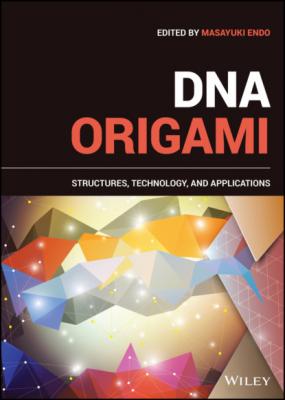DNA Origami. Группа авторов
Читать онлайн.| Название | DNA Origami |
|---|---|
| Автор произведения | Группа авторов |
| Жанр | Отраслевые издания |
| Серия | |
| Издательство | Отраслевые издания |
| Год выпуска | 0 |
| isbn | 9781119682585 |
Figure 3.2 G‐quadruplex induced large deformation of the DNA origami bending actuator. (a) Schematic drawing of the reversible deformation of the nanoarm carrying the G‐quadruplex forming bridge strands. (b) Time‐lapsed AFM images (0.5 frames/second) of K+‐induced deformation of DNA origami nanoarms carrying G‐quadruplex‐forming sequences. While the scanning area was visualized, 30 μl of 1.0 M KCl in a buffer (5 mM Tris–HCl [pH 8.0], 1 mM EDTA, and 15 mM MgCl2) was injected into 130 μl of the buffer in the observation system, so that the final concentration of KCl was 200 mM. The injection was started at 0 second. Scale bar: 200 nm. (c) Changes in the contour lengths and end‐to‐end distances over a time period.
Source: Suzuki et al. [36]/with permission from John Wiley & Sons, Inc.
3.4 Photoresponsive Devices
A variety of DNA nanodevices capable of performing rotations have been realized by employing strand displacement reaction [19, 31,37–39], B–Z transition [40], and combination of metal ion–DNA complex with i‐motif formation [41]. However, these approaches require dilution of the system or lead to by‐product accumulation, causing decreasing yield rates during continuous manipulation. Incorporation of photochromic molecules into the DNA strands can be employed to avoid steps required to remove undesired reaction by‐products [42–44], and thus provide the possibility of manipulating nanodevices by simple photocontrol [45, 46].
In the design of the rotary device reported by Yang et al., a bar‐shaped DNA rotor was functionalized with photoresponsive DNA motifs and incorporated into the rectangular DNA origami stator [47] (Figure 3.3). A bar‐shaped rotor is composed of two double‐crossover (DX) tiles linked with a rigid shaft synthesized from an oligonucleotide‐oligo (phenylene ethynylene, OPE) [48] (Figure 3.3a,b). The two photoresponsive DNA motifs, OFF‐ and ON‐switching motifs, carry azobenzenes and act as switches to release or lock the rotor at specific orientations on the stator in response to photoirradiation. The OFF‐switching motif is composed of two pseudocomplementary oligonucleotides, OFF‐1 and OFF‐2, carrying four and three azobenzene molecules, respectively, enabling their dissociation under UV and association under visible light (Vis) irradiation (Figure 3.3c). The ON‐switching motif is also composed of two oligonucleotides (ON‐1 and ON‐2); however, each strand carries three azobenzenes and forms a loop and stem segment in an intramolecular fashion, leaving a sticky end (Figure 3.3d). Upon UV irradiation, the stem segment of ON‐switching motifs dissociates to open, followed by hybridization between complementary segments of ON‐1 and ON‐2. The OFF‐1 and ON‐1 motifs were individually introduced into terminals of the rotor (azo‐rotor), while two OFF‐2 and two ON‐2 counterpart motifs were placed at four symmetrical anchoring positions on the origami stator (Figure 3.3e).
Figure 3.3 Photoregulated DNA rotary device. (a) A bar‐shaped rotor composed of two DX tiles joined by a rigid shaft synthesized from an oligonucleotide‐oligo(‐phenylene ethynylene) conjugated component. (b) AFM image of the rotor containing two DX tiles. Scale bar = 50 nm. (c) OFF‐switching motifs (OFF‐1 and OFF‐2): a pair of pseudocomplementary strands containing seven azobenzenes, which dissociated after UV irradiation. (d) ON‐switching motifs (ON‐1 and ON‐2): a pair of hairpin DNA structures containing three azobenzenes in each strand that formed a 10 bp duplex after UV irradiation. (e) Construction of the DNA rotary system and its conversion under photoirradiation. OFF‐1 and ON‐1 strands were incorporated into both terminals of the rotor (azo‐rotor). Two OFF‐2 (anchorages 1 and 2) and two ON‐2 (anchorages 3 and 4) strands were introduced into the DNA origami stator. The azo‐rotor was trapped at anchorages 1 and 2 by the formation of the OFF duplex in the perpendicular state (A or A′). The azo‐rotor was trapped at anchorages 3 and 4 by the formation of the ON duplex in the parallel state (B or B′). The releasing and trapping of the azo‐rotor were regulated by photoirradiation with UV and visible light (Vis). (f) Time‐lapsed AFM images of the azo‐rotor rotated from the perpendicular state to the parallel state under UV irradiation. Scanning rate: 0.2 frames/second. Scale bar: 50 nm. (g) Time‐lapsed AFM images of the rotor rotated from the parallel state to the perpendicular state under visible light irradiation. Scanning rate: 0.2 frames/second. Scale bar: 50 nm.
Source: Yang et al. [47]/with permission from John Wiley & Sons, Inc.
The photoresponsive changes of the azo‐rotor on a single DNA origami stator were monitored by HS‐AFM at a time resolution of seconds. The purified sample was adsorbed onto the mica and then photoirradiated while keeping continuous AFM scanning. Successive AFM images obtained under UV irradiation revealed changes in the azo‐rotor orientation (Figure 3.3f). The azo‐rotor was initially locked in vertical orientation, but was released to rotate and was finally locked in the horizontal orientation. At 30 and 35 seconds, the azo‐rotor was not clearly imaged on the stator, yet reappeared in the frame at 40 seconds, probably due to the rapid molecular motion of the azo‐rotor after the dissociation of the OFF duplex. After the fluctuations of the rotor released by the UV‐induced dissociation of the OFF‐switching motif, it turned back to the OFF‐switch anchor position (40 seconds) probably due to failure of hybridization to the ON‐switching motif. The azo‐rotor again exhibited fluctuations in its orientation from 55 to 70 seconds and was finally locked in the horizontal orientation. Reverse change from the horizontal to vertical orientation was also monitored by scanning a pre‐UV‐irradiated sample. In the initial frame of the successive images (before Vis irradiation, Figure 3.3g), OFF‐2 and ON‐2 on the stator were clearly identified at anchorages 1 and 4, respectively, indicating the azo‐rotor was locked in the horizontal orientation at anchorage 3. After irradiation with Vis light, the azo‐rotor rotated quickly to the vertical orientation (5–10 seconds),
